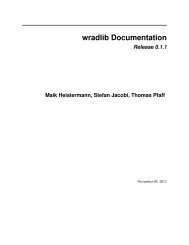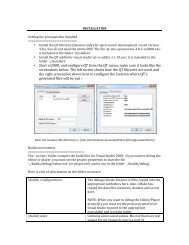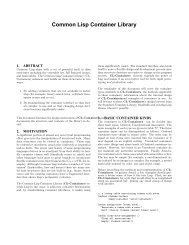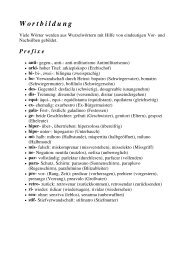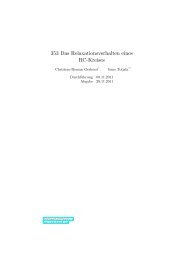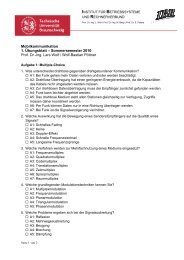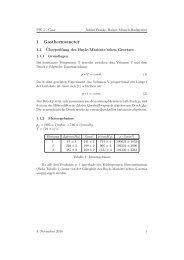P-Technique Demonstrated in Determining ... - Bitbucket
P-Technique Demonstrated in Determining ... - Bitbucket
P-Technique Demonstrated in Determining ... - Bitbucket
You also want an ePaper? Increase the reach of your titles
YUMPU automatically turns print PDFs into web optimized ePapers that Google loves.
RAYMOND B. CATTELL, A. K. S. CATTELL, AND R. M. RHYMER 277<br />
other factors. Consequently it seems most likely that the factorization<br />
of the present personality factor matrix will actually yield firstorder<br />
factors, each be<strong>in</strong>g "po<strong>in</strong>ted" by high load<strong>in</strong>g <strong>in</strong> the rated factor<br />
<strong>in</strong>tended to represent it, but also <strong>in</strong>volved to some extent <strong>in</strong> other<br />
"factor" rat<strong>in</strong>gs. This likelihood is <strong>in</strong>creased by the fact that the personality<br />
sphere represented is likely to be widened through the <strong>in</strong>clusion<br />
of test and questionnaire variables. The exam<strong>in</strong>ation of the correlation<br />
matrix before factorization revealed no correlations between<br />
test factors and behavior factors high enough to suggest identity, nor<br />
were the significant r's of a test factor conf<strong>in</strong>ed to one behavior factor.<br />
The actual factorization aga<strong>in</strong> yielded four factors, accord<strong>in</strong>g to<br />
both the Tucker and the McNemar criteria. However, <strong>in</strong> this case the<br />
presumption that more factors should be <strong>in</strong>volved was so great and<br />
the <strong>in</strong>dications of a factor special to three variables <strong>in</strong> the residual<br />
was so strong that we decided to extract a fifth factor, slight though<br />
it was, and attempt rotation with it. Aga<strong>in</strong> simple structure was obta<strong>in</strong>ed<br />
with unusual def<strong>in</strong>iteness and <strong>in</strong>evitableness (over half the<br />
variables <strong>in</strong> the hyperplane) <strong>in</strong> the case of three factors. This occurred<br />
after four rotations <strong>in</strong> each. Another 25 rotations, however, were required<br />
to achieve simple structure on the two rema<strong>in</strong><strong>in</strong>g factors,. 1<br />
and 5; and then, though satisfactory, they did not sit at comfortable<br />
angles near to orthogonality as did the first three factors. Rotation<br />
with the first four factors only yielded simple structure fairly readily<br />
with two, but eighteen more rotations were necessary to get simple<br />
structure with the rema<strong>in</strong>der. Three of these factors are practically<br />
<strong>in</strong>dist<strong>in</strong>guishable <strong>in</strong> load<strong>in</strong>g pattern from Factors A, F, and C above.<br />
The fourth is also clearly the same as G above, but absorbs greater<br />
variance. The second cyclothyme factor H is therefore miss<strong>in</strong>g. These<br />
factors do not have such good hyperplanes as <strong>in</strong> the accepted rotation ;<br />
<strong>in</strong> fact, only 60% of the number <strong>in</strong> the five-factor solution.<br />
In view of the co<strong>in</strong>cidence of the number of factors obta<strong>in</strong>ed --4<br />
to 5-- with the number obta<strong>in</strong>ed <strong>in</strong> two studies (7) of second-order<br />
personality factors, the first hypothesis to consider is that <strong>in</strong> spite of<br />
the reasons stated above these factors are <strong>in</strong>deed second-order factors.<br />
A careful comparison of the present load<strong>in</strong>g patterns with those of<br />
the second-order factors (7) reveals no similarity whatever <strong>in</strong> two<br />
and a very distant similarity <strong>in</strong> the rest--so distant that, <strong>in</strong> conjunction<br />
with the absence of any resemblance <strong>in</strong> their <strong>in</strong>tercorrelation, we<br />
feel justified <strong>in</strong> turn<strong>in</strong>g away confidently to the hypothesis orig<strong>in</strong>ally<br />
suggested: that these are first-order factors. That this latter is true<br />
is witnessed by the ease with which the present factors--listed <strong>in</strong><br />
Table 3 below-- can be matched and identified with well-known primary<br />
personality factors from R-technique. We have only to set aside





